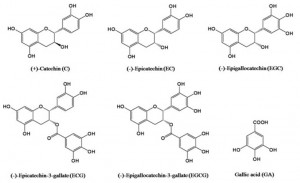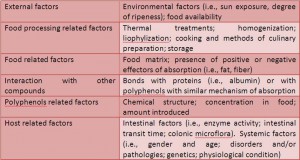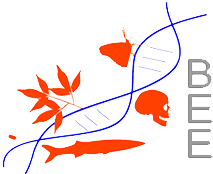Polyphenols, Food and Nutritions ![]()
Alessandro Grosso – Mauro Marra
Abstract:Phenolic compounds in foods have attracted great interest since the 1990s due to growing evidence of their beneficial effects on human health. Studies on polyphenols know no decline. This is due to the continuous and increasing interest by the industries, aimed at trying different shapes or concentrations during the food supplements productions or it is explainable by the people curiosity and partecipations to the health facts that have known better visibility thanks to EFSA and other UE institutions. This is all the more interesting actually because “chemical” food or constituent, do not well accept as “natural” ones, effecting a moving in the consumer market choices and in the scientific knowledge to the second one (without knowing that a natural polyphenols is not different at all by its synthetic homologous, exept the origin!). However, to establish conclusive evidence for the effectiveness of dietary chemically-naturally polyphenols in disease prevention, it is useful to better define the bioavailability of the polyphenols, so that their biological activity can be evaluated. The bioavailability appears to differ greatly among the various phenolic compounds.
Text:The interest in food polyphenols was stimulated mainly by epidemiological studies indicating an inverse association between the intake of foods rich in these compounds and the incidence of diseases, such as cardiovascular disease, diabetes mellitus, and cancer.
The epidemiological evidence for the benefit of consuming a diet rich in foods containing polyphenols is very strong. On the contrary, the evidence for specific fruit or vegetable, and indeed specific phenolic compounds, is actually less convincing, and the best simple advice that can be given is to recommend as much variety as possible.
Much of the evidence on the beneficial effects of dietary polyphenols is derived from experiments performed in vitro or in animal models, and by using concentrations much higher than those generally contained in the human diet. Moreover, often the compounds tested were polyphenol aglycones or their sugar conjugates rather than their active metabolites.
Since the phenolic compounds in dietary sources exhibit potent free radical-scavenging properties, their main role was thought to be as antioxidants involved in protection against lipid peroxidation. However, in the last decade, the mode of action of these compounds has turned out to be more complex than originally expected. In fact polyphenols might exert several other specific biological effects. They can inhibit cancer cell proliferation and cholesterol uptake , modulate different enzymes including telomerase, cyclooxygenase and lipoxygenase, and interact with several signal transduction pathways. Moreover, polyphenols can affect caspase- dependent pathways, cell cycle regulation, and platelet functions, and they are also able to prevent endothelial dysfunctions.
Even though a compound has strong antioxidative or other biological activities in vitro, it would have little biological activity in vivo if little or none of the compound gets to the target tissues. The most abundant polyphenols in our diet are not necessarily those that have the best bioavailability profile. Consequently, it is not only important to know how much of a nutrient is present in specific food or dietary supplement, but it is even more important to know how much of it is bioavailable.
The term “bioavailability” was originally used in pharmacology to define the concept of the “rate and extent to which a drug reaches its site of action”. Although several definitions of bioavailability have been suggested, the most appropriate seems to be as that fraction of an ingested nutrient or compound that reaches the systemic circulation and the specific sites where it can exert its biological action. In other words, it simply means how much of the ingested quantity of the polyphenols is able to exert its beneficial effects in target tissues.
To establish conclusive evidence for the effectiveness of polyphenols in disease prevention and human health improvement, it is essential to determine the distribution of these compounds in our diet, estimating their content in each food, and to identify which of the hundreds of existing polyphenols are likely to provide the greatest effects in the context of preventive nutrition. Finally, it is necessary to know the bioavailability of polyphenols and their metabolites, to evaluate their biological activity in target tissues.
Distribution and Food Content
However the most important food sources are commodities widely consumed in large quantities such as fruit and vegetables, green tea, black tea, red wine, coffee, chocolate, olives, and extra virgin olive oil. Herbs and spices, nuts and algae are also potentially significant for supplying certain polyphenols.
Some polyphenols are specific to particular food (flavanones in citrus fruit, isoflavones in soya, phloridzin in apples); whereas others, such as quercetin, are found in all plant products such as fruit, vegetables, cereals, leguminous plants, tea, and wine. However, generally foods contain complex mixtures of polyphenols. Apples, for example, contain flavanol monomers or oligomers, chlorogenic acid and small quantities of other hydroxycinnamic acids, several quercetin glycosides, and 2 glycosides of phloretin and anthocyanins. The profile of polyphenols for all varieties of apples is practically identical, but the concentrations may significantly differ.
They may range from 0.1 g total polyphenols/kg fresh weight to 10 g/kg in certain varieties of cider apples . Wine also contains a complex mixture of polyphenols, most of which originate in the grape berry. They include flavonols, flavanol, proanthocyanidins, anthocyanins, phenolic acids, hydroxycinnamates and stilbenes. Among these compounds, trans-resveratrol is one of the most studied because it is considered to be the main compound responsible for the benefits of red wine on human health. However, the concentration of this stilbene in red wine varies considerably. For instance, taking only wine produced with Cabernet Sauvignon grapes in Napa Valley (California, USA) into consideration, the 1989 vintage contained 0.09 mg/L resveratrol whereas the 1994 vintage contained as much as 8.9 mg/l.
There is much variation also in the composition and concentration of phenolic compounds among virgin olive oils. They contain at least 36 structurally distinct phenolic compounds, whose total concentration ranges from 0.02 to 600 mg/kg. These discrepancies are explained by multiple factors that have the ability to modify the concentrations of phenolic compounds in foods.
Main Factors Affecting the Bioavailability of the Polyphenols
Bioavailability studies are not easy to carry out, since several potentially affecting factors exist, as illustrated in Table 1. These factors may affect bioavailability directly or by decreasing polyphenol content in food.
The methodology generally exploited to study the bioavailability of the polyphenols has to be considered. The in vivo approach mostly used is the single-dose design. It involves the intake of one portion of food containing the tested polyphenol. In such a way, the increase in blood concentration is transitional and reflects mainly the ability of the organism to take up the polyphenol from the food matrix. Therefore, the observed increase can have only a minor implication for tissue uptake and bioactivity. On the contrary, under conditions of regular intake, even low amounts of polyphenols can be “repeatedly” absorbed and can significantly increase the concentrations both at plasma and cellular level. Definitive conclusions on the bioavailability and bioactivity of a single phenolic compound are difficult to obtain, because of the synergistic effects of the mixture of polyphenols contained in each food matrix tested. This situation may improve in the future, for example, with the use of isogenic lines of onions that differ only in their quercetin contents, allowing comparisons between groups consuming the same food but with different polyphenol contents.
Table 1. Main factors affecting the bioavailability of dietary polyphenols in humans.
Conclusions: The evaluation of the bioavailability of polyphenols has recently been gaining increasing interest as the food industries are continually involved in developing new products, defined as “functional food”, by virtue of the presence of specific polyphenols. Despite the increasing amount of data available, definitive conclusions on bioavailability of most polyphenols are difficult to obtain and further studies are necessary. At least three critical lines of research should be explored to gain a clear understanding of the health beneficial effects of dietary polyphenols:
1. The potential biological activity of the metabolites of many dietary polyphenols needs to be better investigated. In fact, the identification and the quantification of metabolites currently represents an important and growing field of research.
2. Strategies to improve the bioavailability of the polyphenols need to be developed. Moreover it is necessary to determine whether these methods translate into increased biological activity.
3. Whereas in vitro studies shed light on the mechanisms of action of individual dietary polyphenols, these findings need to be supported by in vivo experiments. The health benefits ofdietary polyphenols must be demonstrated in appropriate animal models of disease and inhumans at appropriate doses.
These are important steps for the understanding of the role of the polyphenols in human health, andfor optimizing dietary advice to the population.
Last news on this matter: 14th Oct 2013:
High dietary intake of polyphenols may be associated with up to a 30% reduction in mortality rates in older adults, according to new research that identifies urinary concentrations of polyphenols as a more accurate measure of intake.The research, published in the Journal of Nutrition, is the first to evaluate the total dietary polyphenol intake by using a nutritional biomarker and not only a food frequency questionnaire, explained the Spanish team behind the study.Led by Professor Cristina Andrés Lacueva from the University of Barcelona, the 12-year follow-up study used measures of total urinary polyphenol (TUP) concentrations as a proxy of intake, to assess the effect of polyphenol-rich diets on longevity and risk or mortality.The findings suggest an association between high polyphenol intake and reduction of mortality risk – with those that have the highest polyphenol intake associated with a 30% reduction in mortality. “TUPisanindependentriskfactorformortalityamongcommunity- dwelling older adults, suggesting that high dietary intake of polyphenols may be associated with longevity,” wrote the research team.Results corroborate scientific evidence suggesting that peopleconsuming diets rich in fruit and vegetables are at lower risk of several chronic diseases and overall mortality,” said Raúl Zamora Ros – first author of the study.
The Spanish team analysed data from a population sample of 807 men and women aged 65 or over from Greve and Bagno (Tuscany, Italy), within the InCHIANTI study. Using TUP measures, the group assessed the effect of polyphenol-rich diets – the first time that such a biomarker has been used for an epidemiological or clinical study.
“The development and use of nutritional biomarkers enables to make a more precise and, particularly, more objective estimation of intake as it is not only based on participants’ memory when answering questionnaire,” said Lacueva.
“This methodology makes a more reliable and accurate evaluation of the association between food intake and mortality or disease risk,” she said.
Research results
Using the TUP analysis, the authors found that overall mortality was reduced by 30% in participants who had rich-polyphenol diets (>650 mg/day) in comparison with the participants who had low-polyphenol intakes ( Lacueva and her colleagues noted that during the 12 year follow-up, 274 participants (34%) died. They found that TUP excretion markers (adjusted for age and sex) tended to be greater in participants who survived than in those who died.
However, when the team looked at data on total dietary polyphenols from a food frequency survey, they found no significant differences.
As a result, the team stressed that their study not only suggests the benefits of dietary polyphenols but also underlines the importance of evaluating —if possible— food intake by using nutritional biomarkers, not only food frequency questionnaires.
“Polyphenols might have a role in the prevention of several chronic diseases, but evaluating total dietary polyphenol (TDP) intake from self-reported questionnaires is inaccurate and unreliable,” the team noted.








Università di Tor Vergata